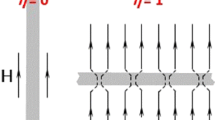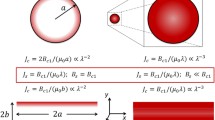Abstract
The importance of accounting for the inhomogeneity of the magnetic field distribution and roundness of domain walls near the surface of type-I superconductors in the intermediate state for forming the equilibrium flux structure was predicted by Landau eight decades ago. Further studies confirmed this prediction and extended it to all equilibrium properties of this state. Here we report on direct depth-resolved measurements of the field distribution and shape of domains near the surface of high-purity type-I (indium) films in a perpendicular field using Low-Energy Muon Spin Rotation spectroscopy. We find that at low applied fields (in about half of the field range of the intermediate state) the field distribution and domains’ shape agrees with that proposed by Tinkham. However, for high fields our data suggest that reality differs from theoretical expectations. In particular, the width of the superconducting laminae can expand near the surface leading to formation of a maximum in the static magnetic field in the current-free space outside the sample. A possible interpretation of these experimental results is discussed.












Similar content being viewed by others
Notes
The healing length Lh is an effective width of a near-surface spatial layer over which the strongly non-uniform induction inside the sample relaxes to its uniform state away from it. The term “effective” implies, that within this layer the field distribution in both in- and out-of-plain projections remains the same as the induction distribution inside the sample; and at distances larger than Lh the field is undisturbed and equal to the applied field H0.
In spite of the large value of the mean free path, an ultimate test of purity of a superconducting sample is reproducibility of its magnetization curve measured with the sample cooled in zero and in non-zero field (see [12] for more details).
This can be understood as follows. Thermodynamics of the IS is based on condition of minimization of the sample free energy [6, 8]. Bending of the field lines makes positive contribution in the free energy and therefore it cannot be strong due to requirement of thermodynamics (see [12] for more details).
References
Seul, M., Andelman, D.: Science 267, 476 (1995)
Faber, I.T.: Proc. Roy. Soc. A 248, 460 (1958)
Livingston, J.D., DeSorbo, W.: In: Parks, R. D. (ed.) Superconductivity, vol. 2, p 1235. Marcel Dekker, New York (1969)
Huebener, R.P.: Magnetic Flux Structures in Superconductors, 2nd edn. Springer, Berlin (2010)
Shoenberg, D.: Superconductivity, 2nd edn. Cambridge University Press, Cambridge (1962)
Tinkham, M.: Introduction to Superconductivity. McGraw-Hill, New York (1996)
Landau, L.D., Lifshitz, E.M., Pitaevskii, L.P.: Electrodynamics of Continuous Media, 2nd edn. Elsevier, Amsterdam (1984)
Kozhevnikov, V., Wijngaarden, R.J., de Wit, J., Van Haesendonck, C.: PRB 89, 100503(R) (2014)
Kozhevnikov, V., Van Haesendonck, C.: Phys. Rev. B 90, 104519 (2014)
Kozhevnikov, V., Valente-Feliciano, A.-M., Curran, P.J., Suter, A., Liu, A.H., Richter, G., Morenzoni, E., Bending, S.J., Van Haesendonck, C.: PRB 95, 174509 (2017)
Kozhevnikov, V., Valente-Feliciano, A.-M., Curran, P.J., Richter, G., Volodin, A., Suter, A., Bending, S.J., Van Haesendonck, C.: J. Supercond. Nov. Magnetism 31, 3433 (2018)
Kozhevnikov, V.: Thermodynamics of Magnetizing Materials and Superconductors. CRC Press, Boca Raton (2019)
Landau, L.D.: Zh.E.T.F. 7, 371 (1937)
Tamm, I.E.: Fundamentals of the Theory of Electricity. Mir, Moscow (1979)
Landau, L.D.: Nature 147, 688 (1938)
Landau, L.D.: Zh.E.T.F. 13, 377 (1943)
De Gennes, P.G.: Superconductivity of Metals and Alloys. Perseus Book Publishing, L.L.C. (1966)
Meshkovsky, A.G., Shalnikov, A.I.: Zh. Eksp. Teor. Fiz. 17, 851 (1947)
Sharvin, Y.V.: Zh.E.T.F. 33, 1341 (1957). [Sov. Phys. JETP 33, 1031 (1958)]
Abrikosov, A.A.: Fundamentals of the Theory of Metals. Elsevier Science Pub Co., Amsterdam (1988)
Gorent, R.N., Tinkham, M.: J. Low Temp. Phys. 5, 465 (1971)
Marchenko, V.I.: Zh. Eksp. Teor. Fiz. 71, 2194 (1976). [JETP 44, 1156 (1976)]
Maxwell, J.C.: A Treatise on Electricity and Magnetism, 2nd edn., vol. II. Clarendon Press, Oxford (1881)
Kozhevnikov, V., Suter, A., Fritzsche, H., Gladilin, V., Volodin, A., Moorkens, T., Trekels, M., Cuppens, J., Wojek, B.M., Prokscha, T., Morenzoni, E., Nieuwenhuys, G.J., Van Bael, M.J., Temst, K., Van Haesendonck, C., Indekeu, J.O.: Phys. Rev. B 87, 104508 (2013)
Sonier, J.E., Brewer, J.H., Kiefl, R.F.: Rev. Mod. Phys. 72, 769 (2000)
Yaouanc, A., Dalmas de Reotier, P.: Muon Spin Rotation, Relaxation, and Resonance. Oxford University Press, London (2011)
Eckstein, W.: Computer Simulation of Ion-Solid Interactions. Springer, Berlin (1991)
Morenzoni, E., Gluckler, H., Prokscha, T., Khasanov, R., Luetkens, H., Birke, M., Forgan, E.M., Niedermayer, C., Pleines, M.: Nucl. Instr. Meth. B 192, 254 (2002)
Suter, A., Morenzoni, E., Garifianov, N., Khasanov, R., Kirk, E., Luetkens, H., Prokscha, T., Horisberger, M.: Phys. Rev. B 72, 024506 (2005)
Kubo, R., Toyabe, T.: In: Blinc, R. (ed.) Magnetic Resonance and Relaxation. North-Holland, Amsterdam (1967)
Prokscha, T., Morenzoni, E., Eshchenko, D.G., Garifianov, N., Glückler, H., Khasanov, R., Luetkens, H., Suter, A.: Phys. Rev. Lett. 98, 227401 (2007)
Chang, G.K., Serin, B.: Phys. Rev. 145, 274 (1966)
Niedermayer, C., Forgan, E.M., Gluckler, H., Hofer, A., Morenzoni, E., Pleines, M., Prokscha, T., Riseman, T.M., Birke, M., Jackson, T.J., Litterst, J., Long, M.W., Luetkens, H., Schatz, A., Schatz, G.: Phys. Rev Lett. 83, 3932 (1999)
Prokscha, T., Morenzoni, E., Deiters, K., Foroughi, F., George, D., Kobler, R., Suter, A., Vrankovic, V.: Nucl. Instr. Meth. Phys. Res. A 595, 317 (2008)
Suter, A., Wojek, B.M.: Phys. Procedia 30, 69 (2012)
Andrew, E.R.: Proc. Roy. Soc. (London) A194, 80 (1948)
Desirant, M., Shoenberg, D.: Proc. Roy. Soc. Lond. A 194, 63 (1948)
Egorov, V.S., Solt, G., Baines, C., Herlach, D., Zimmermann, U.: Phys. Rev. B 64, 024524 (2001)
Shubnikov, L.W., Nakhutin, I.E.: Nature 139, 589 (1937)
Jackson, J.D.: Classical Electrodynamics, 3rd edn. Wiley, New York (1999)
Fisher, M.E.: Private communication
Morenzoni, E., Prokscha, T., Suter, A., Luetkens, H., Khasanov, R.: J. Phys.: Condens. Matter 16, S4583 (2004)
Braunbeck, W.: Z. Physik 112, 753 (1939)
Brandt, E.H.: Science 243, 349 (1989)
Acknowledgments
The muon measurements were performed at the Swiss Muon Source Sμ S, Paul Scherrer Institute, Villigen, Switzerland.
Funding
This work was supported by the National Science Foundation (Grant No. DMR 0904157), by the Research Foundation – Flanders (FWO, Belgium) and by the Flemish Concerted Research Action (BOF KU Leuven, GOA/14/007) research program. V.K. received support from the sabbatical fund of the Tulsa Community College.
Author information
Authors and Affiliations
Corresponding author
Additional information
Publisher’s Note
Springer Nature remains neutral with regard to jurisdictional claims in published maps and institutional affiliations.
Appendix
Appendix
The muon stopping distribution for a given material is calculated with the Monte Carlo code TRIM.SP [27, 28]. Stopping profiles for various muon implantation energies for indium are shown in Fig.13. Figure 14 depicts the muon stopping distribution in solid N2 for a muon implantation energy of E = 14.3 keV.
The average stopping distance (implantation depth) \(\overline {x}(E)\) at given muon energy E is calculated as
where x is the stopping distance and f(x,E) is the stopping distances distribution shown in Figs. 13 and 14.
The out-of-plane coordinate z (shown in Fig. 1b) for the data obtain with muons implanted into the sample equals \(-\overline {x}(E)\); and z for the data measured outside is \(z={\Delta } - \overline {x}(E)\), where Δ is the thickness of the nitrogen overlayer. Details about the depth profiles of the low-energy muons are available in [28, 42].
Figures 15 and 16 show representative data for depolarization rates σTB and σLR, respectively, recorded with IN-A sample without (panels (a)) and with (panels (b)) N2 overlayes.
Rights and permissions
About this article
Cite this article
Kozhevnikov, V., Suter, A., Prokscha, T. et al. Experimental Study of the Magnetic Field Distribution and Shape of Domains Near the Surface of a Type-I Superconductor in the Intermediate State. J Supercond Nov Magn 33, 3361–3376 (2020). https://doi.org/10.1007/s10948-020-05576-1
Received:
Accepted:
Published:
Issue Date:
DOI: https://doi.org/10.1007/s10948-020-05576-1








